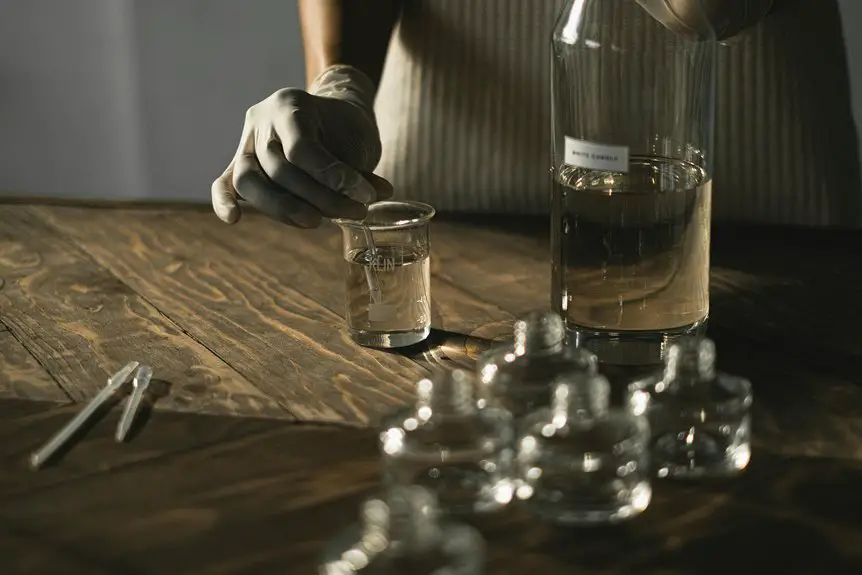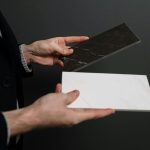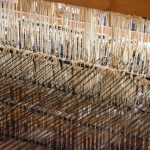To evaluate Kevlar fabric quality, you’ll check its composition, guaranteeing tight molecular alignment and consistent weight and thickness. Test tensile strength to confirm durability under stress. Assess abrasion resistance with methods like Martindale or Taber tests, and evaluate heat and flame resistance by measuring char time and strength loss. Don’t forget impact and ballistic tests for safety standards, plus water repellency and moisture effects. Understanding these steps helps you guarantee Kevlar performs as promised in tough conditions—explore further to master these evaluation techniques.
Table of Contents
Key Takeaways
- Measure fabric weight, thickness, and uniformity to verify compliance with manufacturer specifications and detect manufacturing defects.
- Conduct tensile strength and durability tests to assess load-bearing capacity and resistance to abrasion, flexing, and chemical exposure.
- Perform abrasion resistance tests such as Martindale or Taber to quantify wear cycles and weight loss for durability evaluation.
- Evaluate heat, flame, and moisture resistance through controlled exposure tests, water repellency measurements, and moisture absorption impact analysis.
- Verify impact and ballistic resistance against standards like NIJ, ASTM, and ISO to ensure protective performance and certification compliance.
Understanding Kevlar Fabric Composition
Kevlar fabric owes its remarkable strength to its unique composition, which you need to understand before testing its properties. It’s made from long chains of poly-paraphenylene terephthalamide molecules, aligned tightly to create strong molecular bonds.
This alignment gives Kevlar its exceptional tensile strength and resistance to impact. You’ll find the fibers lightweight yet incredibly durable, with a high resistance to heat and chemical degradation. Recognizing these characteristics helps you appreciate why Kevlar performs so well under stress.
When you examine Kevlar fabric, notice the tightly woven structure—it’s essential for its protective qualities. Understanding this composition makes it easier to interpret test results accurately and assess the fabric’s suitability for various applications, from body armor to industrial uses.
Importance of Tensile Strength Testing
You need to test Kevlar’s tensile strength to measure how durable the material is under stress.
This helps you understand its load-bearing capacity and guarantees it maintains consistent strength in real-world use.
Without these tests, you can’t assure the fabric will perform as expected.
Measuring Material Durability
Tensile strength testing plays an essential role in measuring material durability, as it reveals how much stress a fabric can withstand before breaking.
When you evaluate Kevlar fabric, this test helps predict its lifespan under real-world conditions. Understanding durability guarantees you choose materials that resist wear and tear effectively.
As you measure durability, focus on key factors like:
- Resistance to stretching or deformation under tension
- Ability to maintain structural integrity after repeated stress
- Performance consistency across different fabric batches
- Behavior under sudden or gradual force application
Testing Load-Bearing Capacity
Understanding how a fabric handles stress under tension naturally leads to analyzing its load-bearing capacity.
When you test Kevlar’s tensile strength, you directly measure how much force the fabric can withstand before breaking. This is essential because Kevlar is often used in protective gear where failure isn’t an option.
By applying controlled tension, you see how the fibers respond under real-world stresses, ensuring the fabric can bear heavy loads without snapping. This testing helps you identify weak points or inconsistencies in the weave that might compromise safety.
Ultimately, evaluating load-bearing capacity through tensile testing guarantees the fabric meets performance standards, giving you confidence that it will perform reliably in demanding situations where strength matters most.
Ensuring Consistent Strength
Because Kevlar is relied on for critical applications, guaranteeing consistent strength across fabric batches is essential.
You need to perform tensile strength testing to measure how much force the fabric can withstand before breaking. This helps you identify any weak spots or variations that could compromise safety. By regularly testing, you can maintain quality and trust in the material’s performance.
When you assess tensile strength, you:
- Visualize the fabric stretching under tension
- Detect tiny tears or fiber failures early
- Confirm uniformity in weave and fiber alignment
- Guarantee the fabric meets industry strength standards
Methods for Assessing Abrasion Resistance
Several standardized methods exist to assess the abrasion resistance of Kevlar fabric, ensuring you can accurately gauge its durability under various conditions.
One common approach is the Martindale abrasion test, where the fabric undergoes a controlled rubbing motion against a standard abrasive surface until it shows signs of wear. This helps you determine how many cycles the fabric can withstand before failure.
Another method is the Taber abrasion test, which uses rotating abrasive wheels to simulate long-term wear.
You’ll find these tests provide quantitative data, like the number of cycles to fabric breakdown or weight loss percentage. By choosing the right assessment, you can confidently evaluate Kevlar’s performance for applications requiring high durability and wear resistance.
Evaluating Heat and Flame Resistance
When you test Kevlar fabric for heat and flame resistance, you focus on how well it withstands extreme temperatures without degrading or igniting.
You’ll expose the fabric to controlled flames or heat sources to observe its reaction. Key factors to evaluate include:
- The time it takes for the fabric to start charring or melting
- Whether the fabric self-extinguishes once the flame source is removed
- Changes in tensile strength after heat exposure
- The amount of smoke or toxic gases produced during burning
These tests help you verify the fabric’s safety and durability in high-heat environments, making it reliable for protective gear.
Accurate heat and flame resistance evaluation guarantees that Kevlar meets strict industry standards for thermal protection.
Measuring Impact and Ballistic Performance
Now, you’ll want to focus on how Kevlar holds up under sudden force by conducting impact resistance testing.
Next, assess its ability to stop or slow down projectiles through ballistic penetration assessment.
These tests give you clear insights into Kevlar’s protective performance in real-world scenarios.
Impact Resistance Testing
Although Kevlar fabric is renowned for its strength, you need to rigorously test its impact resistance to guarantee it performs under real-world conditions.
Impact resistance testing simulates sudden forces, helping you understand how Kevlar absorbs and disperses energy. You’ll use specialized equipment to deliver controlled blows, measuring fabric deformation and rebound.
Key steps include:
- Dropping a weighted striker onto the fabric to observe impact absorption
- Recording force transmission through sensors beneath the material
- Evaluating fabric layers for tears or delamination after impact
- Measuring peak force and energy dissipation for comparative analysis
Ballistic Penetration Assessment
Since Kevlar’s primary role often involves stopping bullets, you’ll need to carefully assess its ballistic penetration resistance to confirm it meets safety standards.
You conduct ballistic penetration assessments by firing projectiles at Kevlar samples under controlled conditions, measuring whether the fabric prevents penetration or excessive deformation.
You’ll analyze parameters like projectile velocity, energy absorption, and backface deformation to evaluate performance.
Using standardized testing protocols, such as those from NIJ or MIL-STD, guarantees your results are reliable and comparable.
By tracking these metrics, you can determine if the Kevlar fabric will provide adequate protection in real-world scenarios.
This testing helps you verify that the material not only halts penetration but also minimizes blunt force trauma, ensuring thorough safety for end-users.
Testing for Chemical Resistance and Durability
When you test Kevlar fabric for chemical resistance and durability, you focus on how well it withstands exposure to various substances and physical wear over time. This guarantees the fabric maintains its protective qualities in harsh environments.
You’ll typically expose the fabric to common chemicals like acids, alkalis, and solvents to see if it degrades or loses strength. Then, you simulate wear and tear through abrasion tests and repeated flexing.
Key aspects you assess include:
- Resistance to discoloration and weakening after chemical exposure
- Tensile strength retention post-exposure
- Ability to resist surface abrasion and pilling
- Flex endurance, guaranteeing the fabric doesn’t crack or fray
Water Repellency and Moisture Absorption Tests
You’ll want to measure how well Kevlar fabric repels water using standardized methods to guarantee it performs in wet conditions.
Understanding moisture absorption is also key since it can affect the fabric’s strength and comfort.
Let’s look at how these tests reveal the fabric’s behavior when exposed to water.
Water Repellency Measurement Methods
Although Kevlar fabric is known for its strength and durability, evaluating its water repellency is crucial to confirm peak performance in various conditions.
You can measure water repellency through several reliable methods that simulate real-world exposure and provide quantitative data. Here are some common techniques to contemplate:
- Spray Test: Sprays water over the fabric surface, gauging how droplets bead or absorb.
- Contact Angle Measurement: Measures the angle formed by a water droplet on the fabric to indicate repellency.
- Hydrostatic Pressure Test: Determines the pressure at which water penetrates the fabric.
- Drop Test: Observes the time it takes for a water droplet to be absorbed or rolled off.
Using these methods, you verify your Kevlar fabric meets the necessary standards for water resistance.
Moisture Absorption Impact
Since water repellency alone doesn’t capture the full picture, you should also assess how much moisture Kevlar fabric absorbs under different conditions.
Moisture absorption impacts the fabric’s weight, flexibility, and even protective capabilities. You can conduct tests by exposing the fabric to controlled humidity levels or submerging it briefly, then measuring weight changes to determine absorption rates.
High moisture uptake can weaken Kevlar fibers over time, reducing durability and performance. Additionally, moisture can affect thermal insulation and comfort, so understanding absorption helps predict real-world behavior.
Analyzing Fabric Weight and Thickness Consistency
When you analyze fabric weight and thickness consistency, you guarantee that Kevlar performs reliably under various conditions. Variations can compromise strength, flexibility, and durability, so precise measurement is essential.
Use a calibrated scale to assess weight per unit area and a micrometer for thickness at multiple points. Focus on:
- Uniform weight distribution across the fabric surface
- Consistent thickness to prevent weak spots
- Comparing results to manufacturer specifications
- Identifying anomalies caused by manufacturing defects
Standards and Certifications for Kevlar Fabric
Certifications and standards play an essential role in guaranteeing Kevlar fabric meets the safety and performance expectations required for its applications. When you evaluate Kevlar, you should check for compliance with recognized standards like NIJ, ASTM, and ISO. These certifications confirm the fabric’s protective capabilities and durability. Here’s a quick overview:
| Standard | Focus Area | Importance |
|---|---|---|
| NIJ | Ballistic resistance | Critical for body armor |
| ASTM | Material properties | Guarantees consistent quality |
| ISO | Manufacturing process | Assures reliable output |
Interpreting Test Results for Application Suitability
Although test results provide valuable data, interpreting them correctly is key to determining if Kevlar fabric suits your specific application.
Interpreting test results accurately is essential to ensure Kevlar fabric meets your application’s unique requirements.
You need to focus on how results align with your performance needs rather than just raw numbers. For instance, tensile strength tests tell you if the fabric will withstand expected loads. Abrasion resistance results help assess durability in rough conditions.
Consider these factors when reviewing your test data:
- Does the fabric’s strength exceed the maximum stress it’ll face?
- Will it maintain integrity after repeated wear or flexing?
- How does it perform under temperature or chemical exposure relevant to your use?
- Are the test conditions reflective of your actual operating environment?
Frequently Asked Questions
How Is Kevlar Fabric Manufactured From Raw Materials?
You start by polymerizing chemicals to create long molecular chains, then spin these into fibers through a process called wet spinning. Afterward, you weave or knit the fibers into fabric, ensuring strength and durability.
What Are Common Applications of Kevlar Fabric Beyond Protective Gear?
Think of Kevlar as a superhero fabric! Beyond protective gear, you’ll find it in aerospace, sporting goods, automotive parts, and even musical instruments, giving strength and durability where you least expect it.
How Does Kevlar Fabric Compare Cost-Wise to Other High-Performance Textiles?
You’ll find Kevlar costs more than many high-performance textiles due to its unique strength and durability. However, its long-lasting nature often offsets the initial price, making it a cost-effective choice for critical applications.
Can Kevlar Fabric Be Recycled or Repurposed After Use?
Think of Kevlar as a sturdy puzzle; while you can’t just toss its pieces into a typical recycling bin, you can repurpose or recycle it through specialized programs, helping you give this strong fabric a second life.
What Are the Environmental Impacts of Kevlar Fabric Production?
You should know Kevlar production uses energy and chemicals, leading to emissions and waste. It’s durable, though, so its long lifespan helps reduce frequent replacements, minimizing overall environmental impact compared to less sturdy materials.
- Does Chiffon Fabric Stink - July 15, 2025
- Does Chiffon Fabric Affect the Economy - July 15, 2025
- Does Cotton Fabric Have a Nap - July 15, 2025





